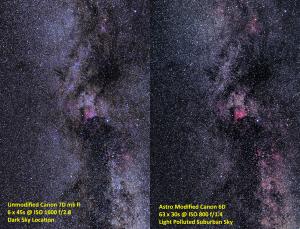Sale on canvas prints! Use code ABCXYZ at checkout for a special discount!

This image needs some explanation (better resolution under https://flic.kr/p/NFyrdj). It is a comparison of the same region of the sky (around the constellation Cygnus), once captured with a regular DSLR from a reasonably dark sky location and once with an astro-modified DSLR from a severely light polluted suburban site. Why this comparison?
When I tell people, that I work with an astro-modified DSLR, I get asked very often what this means and whether such a modification is a must for astrophotography.
The first answer is a bit technical: With the astro-modification, in order to enhance the chip sensitivity for the Hα spectral line at 656,28 nm, the factory installed color balance filter is removed. This boosts the sensitivity to the reds, where most hydrogen nebulas are emitting strongest, up to tenfold, thus enabling the sensor chip to capture more useful light in a given time.
The above answer makes it also clear that the answer to the second question is no, i.e. you can do excellent astrophotography without any modification, by either choosing objects that are emitting light in other wavelengths or by simply exposing longer.
However, the second solution (exposing longer) can prove tricky: In light polluted areas, in order to avoid overexposure due to the artificial brightness of the sky, you have to limit your exposure time.
Furthermore, to record anything usable, you need to capture more light from your target than from sky glow. What you are basically after, is to capture the difference in brightness between your target and the background sky. A dark sky location is therefore best, as the dark sky makes your target stand out better.
If you cannot shoot from a dark sky location, you can increase the sensitivity of your camera to the specific wavelength, where your target is emitting light (that’s what the astro-modification does) or use filters to darken the background sky (light pollution filters or narrow band filters). Of course, both solutions can be combined.
The main disadvantage of the technical solution is that it severely alters the color balance of the resulting image. You can mostly correct this during post processing or you can accept the fact and use it to your advantage, by producing “false-color” images with narrow band filters, highlighting subtle nebulas that cannot be imaged otherwise. Many excellent astrophotographers do the latter with the famous Hubble palette.
However, to my eyes, the non-modified images always look more natural. So why did I buy a modified camera? Well, I quite often shoot in situations where I cannot expose longer. Be it due to the artificial sky glow, when doing telescopic shots from my severely light polluted backyard or to avoid star trails, when shooting nightscapes from a fixed tripod. In both cases the astro-modification does make quite a difference.
Now back to the above image:
-The left side was captured with my non modified camera from a dark site. It is the result of 270s (combined) exposure time and did not need too much post processing. Please note the subtle hues in the North America nebula and the colorful stars.
-The right side was captured with my astro-modified camera from my suburban backyard. The much longer (combined) exposure time and wider aperture means I captured 28-times more light here. Together with the lower ISO and the full frame chip, this made the resulting stacked image much less noisy, allowing me to tone map the image quite extremely during post processing. While the red nebulas stand out a bit better, the subtle blue hues were simply swamped by the polluted sky and the stars do not appear as colorful, due to the exaggerated red sensitivity of the camera.
So what is the quintessence of this post? Astro.mod or not?
Whatever you decide, if you want to do astrophotography, go to a dark sky location!
If you cannot do that or if you are shooting non-tracked nightscapes, an astro-modified camera might be a worthwhile addition to your equipment - if you can afford it.
However, I think my stream proves that you can get quite good results with a regular DSLR.
Therefore, if you want start with astrophotography, just grab your gear, go to a dark spot and give it a try!